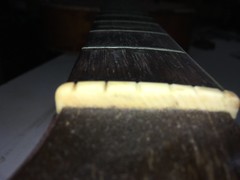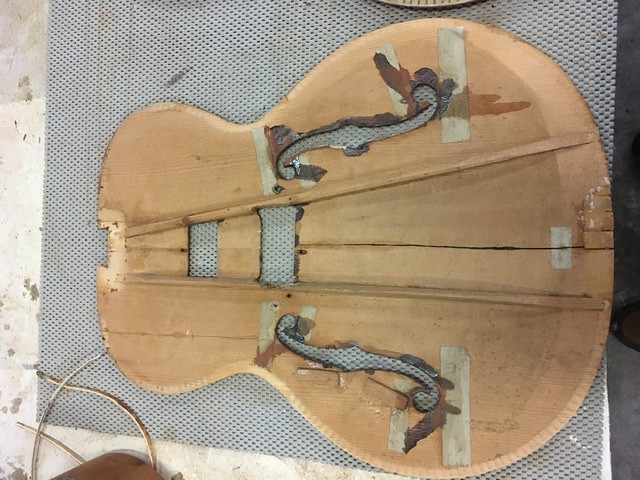Page 2 of 3
Re: Can this live again? 1941 Epiphone Triumph
Posted: Wed Jun 19, 2019 10:08 am
by Clay Schaeffer
Often people sand the fretboard to remove the divots when they are doing a refret. Frank's method has the advantage of building up the divoted area rather than removing a lot of wood. To some they don't pose a problem, to others they are annoying. With today's penchant for relicked finishes it makes as much sense to leave them as remove them. Owner's choice. But it's always good to know various methods to do things, so you can pick what is right for you.
Re: Can this live again? 1941 Epiphone Triumph
Posted: Thu Jun 20, 2019 2:31 pm
by Steven Smith
Clay Schaeffer wrote:Often people sand the fretboard to remove the divots when they are doing a refret. Frank's method has the advantage of building up the divoted area rather than removing a lot of wood. To some they don't pose a problem, to others they are annoying. With today's penchant for relicked finishes it makes as much sense to leave them as remove them. Owner's choice. But it's always good to know various methods to do things, so you can pick what is right for you.
Frank's method works very well and allows you to clean up and level the fretboard with minimal sanding. I don't worry about all the divots (unless that is the client's wish), I just take care of the large craters.
Re: Can this live again? 1941 Epiphone Triumph
Posted: Mon Oct 21, 2019 10:13 pm
by Roger Rosenberger
Re: Can this live again? 1941 Epiphone Triumph
Posted: Mon Oct 21, 2019 10:30 pm
by Roger Rosenberger
So I finally got a little time to work on this. It's going to a long process since I only have a couple hours a week at the most to work on it.
I took a closer look and noticed there was an oak dowel rod in the heel. It was what I was afraid it might be, somebody put a big wood screw in the heel.
I drilled out the dowel but couldn't get the screw to move so I drilled out the center of screw to get it out. More work!


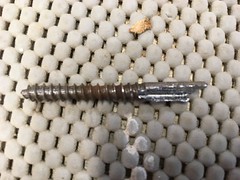
I removed the back and see more evidence that they used a chemical stripper at some point. The old finish dripped through the F holes on to the back.
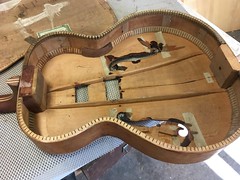

Lots of work ahead.
Re: Can this live again? 1941 Epiphone Triumph
Posted: Wed Oct 30, 2019 9:34 pm
by dave richard
Hi Roger, a worthwhile project! It will be quite a bit of work, but these old NY Epis are very fine instruments(I own five, at the moment), a '34, '36' '43, '47, and a '41 project. Two needed extensive repairs(you can see photos/descriptions of the guitars at my facebook page, David Richard Luthier. I look forward to more progress photos of you Triumph.
Dave
Re: Can this live again? 1941 Epiphone Triumph
Posted: Wed Nov 13, 2019 10:53 am
by Mark Wybierala
Been a while since I looked at this post. You're in scary territory for me -- but I'm jealous. ...yes, a worthwhile project.
Re: Can this live again? 1941 Epiphone Triumph
Posted: Fri Jan 10, 2020 3:03 pm
by Roger Rosenberger
Re: Can this live again? 1941 Epiphone Triumph
Posted: Fri Jan 10, 2020 3:07 pm
by Roger Rosenberger
I added a hardwood dowel to fill that back in and reshaped the dovetail. It fits decent now but still needs a little more work.

Re: Can this live again? 1941 Epiphone Triumph
Posted: Fri Jan 10, 2020 3:14 pm
by Roger Rosenberger
Made a template that matched the arch so I could use my router and pattern bit to take out the majority of the top I want to replace. I didn't want to remove the bracing so I just shaved the top off of the bracing.
Now I have some hand work to do making the ramps and fitting the patch.
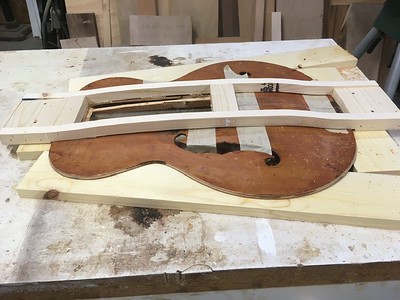

Re: Can this live again? 1941 Epiphone Triumph
Posted: Fri Jan 10, 2020 3:21 pm
by Roger Rosenberger
Now another issue has popped up. I want to reuse this part of the Frequensator but see there's about a 3/4" long crack in it. Would a good silver solder hold?
I've done some welding and brazing but have not used solder other than for wiring. I see some of the silver solders claim a tensile strength of up to 80,000 psi? Any advice would be appreciated.

Re: Can this live again? 1941 Epiphone Triumph
Posted: Fri Jan 10, 2020 3:29 pm
by Roger Rosenberger
I did get to talk with the owner for a while during Christmas. Full disclosure, he's my son-in-law who lives in Colorado and I'm in Illinois. So this is a not a job for profit but more of a challenge, but of course I still want to do a good job.
We talked about finishes that might cover all the repairs in the top and he mentioned a reverse sunburst. Would that be out of line for this instrument? Any examples?
Re: Can this live again? 1941 Epiphone Triumph
Posted: Fri Jan 10, 2020 3:45 pm
by Barry Daniels
Very clever router sled there.
The silver solder should be up to the task if you can get a good joint. Sometimes it is hard to get it to flow out in an old crusty crack like that. You should open it up so that you can file/sand the edges of the break and then use some flux.
I am not sure about the sunburst idea. The top is so rough that you either will have to sand it a bunch, or just finish with a dark stain.
Re: Can this live again? 1941 Epiphone Triumph
Posted: Sat Jan 11, 2020 12:07 am
by Clay Schaeffer
Hi Roger,
You might want to consider removing the remaining section of top wood at the upper edge of your cut out. The new wood would tie into the top block and it would eliminate a cross grain joint which can be hard to hide. At the lower end the cross grain joint will be hidden under the bridge. Eliminating the short section of top at the neck block area will also make the new wood much easier to fit - you will only need to fit 3 sides instead of four (the forth side can be left long and trimmed to length after the other 3 are fitted and glued in place.
I don't think a reverse sunburst would look good on this instrument, but a normal burst might be fine. If you can't find wood that matches the color of the original you may be able to chemically age the new wood and lightly stain the whole top to color match the new and old. Then a fairly dark burst might pull it all together.
Re: Can this live again? 1941 Epiphone Triumph
Posted: Sat Jan 11, 2020 5:19 am
by Michael Lewis
The granular texture of the metal at the crack is due to work hardening and fatigue. The crack is only part of the condition, but it should become annealed (made 'dead soft') if you use silver solder. Lots of tail pieces have cracked like this, they need to be annealed to prevent the metal from developing the granular condition. The part should have been annealed before it was plated, then this probably would not have happened. Oh yeah, by heating the part enough to anneal it you will pretty much destroy the existing plating, so you might consider having it re-plated after you repair it. Also, you can make a new part that looks very much like the original one. Just make sure it is annealed after it is formed. By annealing the metal you prevent the granular condition and the inherent brittleness that accompanies this condition.
Re: Can this live again? 1941 Epiphone Triumph
Posted: Sat Jan 11, 2020 9:50 am
by Brian Evans
My 1946 Epi's frequensator cracked there and was brazed/soldered, and has stood the test of time since. It's a sunburst, they did sunbursts on most guitars up to the advent of TV and the desire to be a bit more stand-out, I think. Sunbursts sometimes get accused of covering up less desirable wood choices, and have been done with almost opaque finish.
Re: Can this live again? 1941 Epiphone Triumph
Posted: Sat Jan 11, 2020 6:38 pm
by Roger Rosenberger
Thanks for all the replys.
I’ll try to solder the tailpiece. If it doesn’t work I’ll just get a replacement, I don’t have the original trapeze parts anyway.
A three sided patch would be easier to fit but my concern is holding it altogether until the patch is glued in. I’ll have to think about that for a bit. I do have some aged spruce that should match well.
As for the reverse burst I agree it would look odd. I can only find a couple of examples online and don’t really like the look. It will probably get a dark stain, no burst.
Re: Can this live again? 1941 Epiphone Triumph
Posted: Sun Jan 12, 2020 3:05 pm
by Clay Schaeffer
If you are concerned with the alignment of the top you could hot melt glue a temporary brace that would "float" above the patch area before you remove that last section of top (hot melt glue can be removed with alcohol). Cross grain patches usually stick out like a sore thumb - one reason why many repair books suggest beginning and ending patches at an edge or under another element (bridge, pick guard, etc). If the wood matching and finish work is done well the repair could be inconspicuous .
Re: Can this live again? 1941 Epiphone Triumph
Posted: Sun Jan 12, 2020 3:26 pm
by Brian Evans
That part of the tailpiece is not reproduced (not to that pattern, anyway), and can be easily repaired by a jeweler - mine was decades ago. The two bails that hold the strings are quite available.
Re: Can this live again? 1941 Epiphone Triumph
Posted: Sun Jan 12, 2020 6:50 pm
by Barry Daniels
I once used regular old lead/tin solder to make an extra wide jack plate out of two jack plates. It has suprisingly held up for several years.
Re: Can this live again? 1941 Epiphone Triumph
Posted: Mon Feb 03, 2020 2:44 am
by Michael Lewis
Brian Evans, can you tell what type of finish in on your Epiphones? I recall a '40s Broadway model in my shop about 15 years ago that had some issues to sort. The back and top had loose areas and the finish was flaking. The finish was not effected by lacquer thinner, so I surmised it was a varnish, but it would be good to know for certain.



